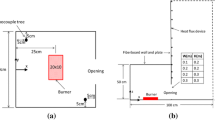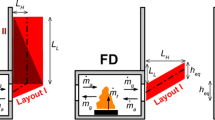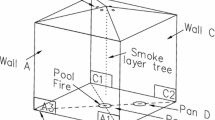Abstract
The prediction performance of design fire curves is numerically investigated for tunnel fire using the fire dynamics simulator (FDS). A large eddy simulation (LES) was adopted in the simulation of a previous 750 kW tunnel fire experiment. Based on the experimental heat release rate, t2-fire growth, quadratic and exponential design fire curves (DFCs) are mathematically constructed and adopted in the FDS simulation. The predictions of each DFCs are compared against the experimentally measured smoke temperature, smoke travel time, and carbon monoxide (CO) concentration. In addition, the prediction performance of the mixture fraction (MF) and mixing controlled fast chemistry (MCFC) combustion models, is compared. The simulation results of the MF and MCFC models are similar except for the CO concentration features. For the performance of the DFCs, t2-fire growth curve with the MF combustion model is the most effective combination, which demonstrated the most reasonable agreement with the experimental data.
Similar content being viewed by others
Abbreviations
- E tot :
-
Total calorific value (kJ)
- k :
-
Time width coefficient
- n :
-
Retard index
- \(\dot Q\) :
-
Heat release rate (kW)
- \({\dot Q_{\max }}\) :
-
Maximum heat release rate (kW)
- \({\dot Q_{{\rm{max}},av}}\) :
-
Average maximum heat release rate (kW)
- r :
-
Amplitude coefficient
- t :
-
Time (s)
- t d :
-
Decay phase starting time (s) t2-fire growth curve
- t D :
-
Decay phase starting time (s) quadratic curve
- t end :
-
End time of fire (s)
- t h :
-
Level-off time (s)
- t o :
-
Ignition onset time (s)
- α d :
-
Fire decay rate (kW/s2) t2-fire growth curve
- α D,q :
-
Fire decay rate (kW/s2) quadratic curve
- α g :
-
Fire growth rate (kW/s2) t2-fire growth curve
- α gq :
-
Fire growth rate (kW/s2) quadratic curve
- a,b,x,y, z :
-
Mole proportions
- C :
-
Empirical constant
- c p :
-
Specific Heat capacity (J/kg K)
- \({D \over {Dt}}\) :
-
Material derivative
- D α :
-
Diffusion coefficient (m2/s)
- D LES :
-
Turbulent thermal diffusivity (kg /m s)
- g :
-
Gravitational acceleration (m/s2)
- h s :
-
Sensible enthalpy (kJ/kg)
- h α :
-
Enthalpy of species α (kJ/kg)
- k :
-
Thermal conductivity (W /m K)
- k LES :
-
Turbulent thermal conductivity (W /m K)
- k(T):
-
Reaction rate constant (cm3/mol s)
- \(\dot m_\alpha ^{'''}\) :
-
Volumetric mass production rate (kg/m3 s)
- \(\dot m_{\alpha ,1}^{'''}\) :
-
\(\dot m_\alpha ^{'''}\) in the first reaction step (kg/m3 s)
- \(\dot m_{\alpha ,2}^{'''}\) :
-
\(\dot m_\alpha ^{'''}\) in the second reaction step (kg/m3 s)
- p :
-
Thermodynamic pressure (Pa)
- Pr t :
-
Turbulent Prandtl number
- \({\dot q^{'''}}\) :
-
Heat release rate per unit volume (kW/m3)
- \(\dot q_{\max }^{'''}\) :
-
Maximum \({\dot q^{'''}}\) (kw/m3)
- \(\dot q_r^{'''}\) :
-
Net thermal radiation energy (kW/m3)
- \(\dot q_r^{'''}\) :
-
Radiative heat flux (kW/m2)
- R :
-
Universal gas constant (J/mol K)
- s:
-
Mass stoichiometric coefficient of oxygen
- Sc t :
-
Turbulent Schmidt number
- sgs :
-
Sub-grid scale
- t :
-
Time (s)
- T :
-
Temperature (K)
- u :
-
Velocity vector (m/s)
- W:
-
Molecular weight of species (kg)
- x − (1 − XH)Vs :
-
Carbon atoms that not converted to soot.
- X H :
-
Hydrogen fraction in soot
- Y α :
-
Species mass fraction
- y CO :
-
CO yield
- Y I F :
-
Mass fraction of fuel in the inlet stream
- \(Y_{{N_2}}^\infty \) :
-
Ambient mass fraction of nitrogen
- \(Y_{{O_2}}^\infty \) :
-
Ambient mass fraction of oxygen
- y s :
-
Soot yield
- Z :
-
Mixture fraction (kg/kg)
- Z1, Z2, Z2 :
-
Mixture fraction variables
- α:
-
General term to represent the gas species
- ΔHF :
-
Heat of formation of fuel (kJ/mol)
- ΔHCO :
-
Heat of formation of CO (kJ/mol)
- Δh0f,a :
-
Heat of formation of species a (kJ/mol)
- ρ :
-
Density (kg/m3)
- Tij :
-
Viscous stress
- T sgs ij :
-
Sub-grid scale (SGS) stress
- T dev ij :
-
Total deviatoric stress
- T :
-
Mixing time scale (s) MF model
- T mix :
-
Mixing time scale (s) MCFC model
- μ:
-
Dynamic viscosity (kg /m s)
- v:
-
Stoichiometric coefficient
- δ:
-
Kronecker delta
- δx, δy, δz:
-
Filter width size along x, y, and z directions (m)
References
H. Ingason, Y. Z. Li and A. Lonnermark, Tunnel Fire Dynamics, Springer, New York (2014).
Y. He, Smoke temperature and velocity decays along corridors, Fire Safety Journal, 33 (1) (1999) 71–74.
Y. Wu and M. Z. A. Bakar, Control of smoke flow in tunnel fires using longitudinal ventilation systems — a study of the critical velocity, Fire Safety Journal, 35 (4) (2000) 363–390.
L. H. Hu, R. Huo, Y. Z. Li, H. B. Wang and W. K. Chow, Full-scale burning tests on studying smoke temperature and velocity along a corridor, Tunnelling and Underground Space Technology, 20 (3) (2005) 223–229.
L. H. Hu, R. Huo, W. Peng, W. K. Chow and R. X. Yang, On the maximum smoke temperature under the ceiling in tunnel fires, Tunnelling and Underground Space Technology, 21 (6) (2006) 650–655.
L. H. Hu, R. Huo, H. B. Wang, Y. Z. Li and R. X. Yang, Experimental studies on fire-induced buoyant smoke temperature distribution along tunnel ceiling, Building and Environment, 42 (11) (2007a) 3905–3915.
L. H. Hu, N. K. Fong, L. Z. Yang, W. K. Chow, Y. Z. Li and R. Huo, Modeling fire-induced smoke spread and carbon monoxide transportation in a long channel: Fire dynamics simulator comparisons with measured data, Journal of Hazardous Materials, 140 (1–2) (2007b) 293–298.
L. H. Hu, J. W. Zhou, R. Huo, W. Peng and H. B. Wang, Confinement of fire-induced smoke and carbon monoxide transportation by air curtain in channels, Journal of Hazardous Materials, 156 (1–3) (2008) 327–334.
L. H. Hu, F. Tang, D. Yang, S. Liu and R. Huo, Longitudinal distributions of CO concentration and difference with temperature field in a tunnel fire smoke flow, International Journal of Heat and Mass Transfer, 53 (13–14) (2010) 2844–2855.
Y. F. Li, J. Bian and J. M. Li, Research on smoke flow in a tunnel fire of subway system, Procedia Engineering, 71 (2014) 390–396.
A. Sojoudi, H. Afshin and B. Farhanieh, An analysis of carbone monoxide distribution in large tunnel fires, Journal of Mechanical Science and Technology, 28 (5) (2014) 1917–1925.
H. Ingason, Design fire curves for tunnels, Fire Safety Journal, 44 (2) (2009) 259–265.
L. Staffansson, Selecting Design Fires, Report 7032 Lund 2010, Department of Safety Engineering and Systems Safety, Lund University, Sweden (2010).
H. J. Kim and D. G. Lilley, Heat release rates of burning items in fires, 38thAIAA Aerospace Sciences Meeting and Exhibit, AIAA 2000-0722, Nevada (2000) 1–26.
V. Babrauskas and R. D. Peacock, Heat release rate: The single most important variable in fire hazard, Fire Safety Journal, 18 (3) (1992) 255–272.
H. Ingason, Fire development in large tunnel fires, 8th International Symposium on Fire Safety Science, Beijing (2005) 1497–1508.
H. J. Kim and D. G. Lilley, Fire dynamic calculations and illustrations, 44thAIAA Aerospace Sciences Meeting and Exhibit, AIAA 2006-179, Nevada (2006) 1–22.
D. G. Lilley, Fire development calculations, Journal of Propulsion and Power, 16 (4) (2000) 641–648.
B. Baek, C. B. Oh, E. J. Lee and D. G. Nam, Application study of design fire curves for liquid pool fires in a compartment, Fire Science and Engineering, 31 (4) (2017) 43–51.
K. McGrattan, R. McDermott, S. Hostikka and J. Floyd, Fire Dynamics Simulator (version 5.5) Technical Reference Guide, National Institute of Standards and Technology, NIST Special Publication 1018-5 (2010a).
K. McGrattan, R. McDermott, S. Hostikka and J. Floyd, Fire Dynamics Simulator (version 5.5) User’s Guide, National Institute of Standards and Technology, NIST Special Publication 1019-5 (2010b).
K. McGrattan, R. McDermott, S. Hostikka, J. Floyd, C. Weinschenk and K. Overholt, Fire Dynamics Simulator (version 6.3.2) Technical Reference Guide, National Institute of Standards and Technology, NIST Special Publication, 1018-1 (2015a).
K. McGrattan, R. McDermott, S. Hostikka, J. Floyd, C. Weinschenk and K. Overholt, Fire Dynamics Simulator (version 6.3.2) User’s Guide, National Institute of Standards and Technology, NIST Special Publication, 1019 (2015b).
J. E. Floyd and K. B. McGrattan, Extending the mixture fraction concept to address under-ventilated fires, Fire Safety Journal, 44 (3) (2009) 291–300.
D. Yang, L. H. Hu, Y. Q. Jiang, R. Huo, S. Zhu and X. Y. Zhao, Comparison of FDS predictions by different combustion models with measured data for enclosure fires, Fire Safety Journal, 45 (5) (2010) 298–313.
G. H. Yeoh and K. K. Yuen, Computational Fluid Dynamics in Fire Engineering Theory, Modelling and Practice, Elsevier, Oxford (2009).
Ü. Ö. Köylü and G. M. Faeth, Carbon monoxide and soot emissions from liquid-fueled buoyant turbulent diffusion flames, Combustion and Flame, 87 (1) 61–76.
B. Baek, C. B. Oh, C. H. Hwang and H. S. Yun, Evaluation of the prediction performance of FDS combustion models for the CO concentration of gas fires in a compartment, Fire Science and Engineering, 32 (1) (2018) 7–15.
Acknowledgments
This research was carried out with the support from the field-based firefighting activity-supporting technology development project of the National Fire Agency (MPSS-Fire Safety-2015-66), Republic of Korea.
Author information
Authors and Affiliations
Corresponding author
Additional information
Dinesh Myilsamy is a Ph.D. student in the Department of Safety Engineering at Pukyong National University. He received his Master’s degree in Safety Engineering in the year of 2017. His research interest include computational fire dynamics, and combustion engineering.
Chang Bo Oh is a Professor in the Department of Safety Engineering at Pukyong National University. He received his Ph.D. degree in Mechanical Engineering from Inha University, Korea, in 2003. His research interests include computations of safety-related problems, such as toxic chemical spread, combustion, fire and explosion.
Chi Young Lee is an Associate Professor in the Department of Fire Protection Engineering at Pukyong National University. He received his Ph.D. degree in Mechanical Engineering from KAIST, Korea. His research interests include fire and thermal-fluids engineering.
Rights and permissions
About this article
Cite this article
Myilsamy, D., Oh, C.B. & Lee, C.Y. Numerical investigation of prediction performance of design fire curves for a tunnel fire. J Mech Sci Technol 34, 3875–3887 (2020). https://doi.org/10.1007/s12206-020-0838-4
Received:
Revised:
Accepted:
Published:
Issue Date:
DOI: https://doi.org/10.1007/s12206-020-0838-4




